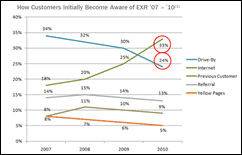Content Marketing in a Blink: The Content Grid v2 [Infographic] | Eloqua Blog
Oct 18, 2011 03:59 pm
Does your company have a Markishing department yet? That’s a Marketing/Publishing department, and if you don’t you better start working on it.
This infograph from Eloqua illustrates the power of content at various stages of the purchasing cycle. You don’t have to be an enterprise to be using this kind of markishing approach to marketing. Learn about content development and cascades in my up-coming book.
Tags: content marketing publishing content infograph eloqua
read more
‘Try demo’ or ‘Buy now’: A/B testing finds which button increased clickthroughs by 47%
Oct 18, 2011 03:25 pm
In my new book — see preview on Facebook — I isolate five conversion signatures, one of which is right for your website. One is the Site as a Service signature, and the first conversion strategy is “Turn Visitors into Tryers.”
This case study bears out the importance of that strategy. SaaS sites have an advantage over ecommerce sites in that their visitors can try the product right there on site. Why not offer a trial? Find out the other strategies in a free video introducing the book’s core concepts.
Tags: demo buy testing button call to action
read more
12 Important Places You’re Forgetting to Add Calls-to-Action
Oct 17, 2011 07:55 am
“I may have an answer to your questions.”
Doesn’t this sound hopeful? And you do. Whatever industry you are in, it is fundamentally your duty to understand your market’s problems and to figure out how to solve them. The philosophy of content marketing is that teaching prospects about their problems is as important as teaching them about your solutions.
So, if you have some helpful knowledge that helps prospects solve problems, how are you letting them know that you’re there for them?
Here are twelve ways to call attention to what you offer. Then you can let the content speak volumes for your solutions.
Tags: content content marketing call to action conversion
read more












